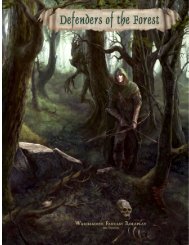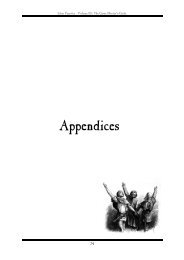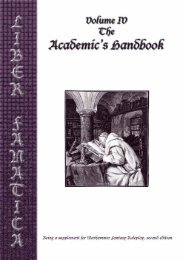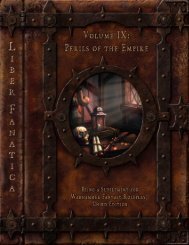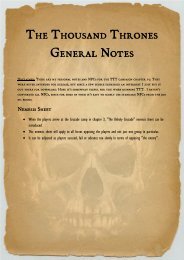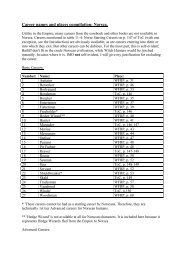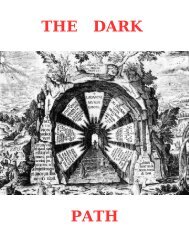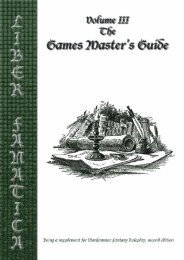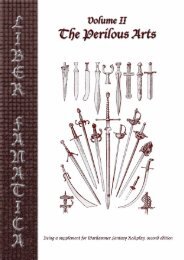1.56 MB Download - Liber Fanatica
1.56 MB Download - Liber Fanatica
1.56 MB Download - Liber Fanatica
Create successful ePaper yourself
Turn your PDF publications into a flip-book with our unique Google optimized e-Paper software.
<strong>Liber</strong> <strong>Fanatica</strong> - Volume IV: The Academic’s Handbook<br />
island of Hoeth. In this way, the quantity of<br />
ambient magic in the Old World is generally<br />
maintained at levels that aren’t dangerous.<br />
This all means, however, that magic transported<br />
by the network can be tapped. In order to do this,<br />
one must be close to a leyline or a stone circle.<br />
The bonus this generates is dependent on the<br />
strength of the magical flow through that<br />
particular section of the network (and thus<br />
dependent the GM’s discretion). The amount of<br />
magic transported through a section of the<br />
network is not always equal, either, so the bonus<br />
can differ from one day to the next.<br />
Study and Experiment<br />
In order to find out about arcane connection, a<br />
wizard has either to experiment or study the<br />
results of other wizard’s experiments. Items can<br />
have subtle sympathies toward a lot of magical<br />
effects, only a few of which are directly obvious. It<br />
doesn’t take a genius to understand that a raven<br />
has correspondences to spells of flight and of<br />
death, but four hundred years ago, Magister<br />
Orfalase di Scorcio identified a hundred and<br />
seven different correspondences for a raven, and<br />
listed them all in his famous monography. A few<br />
more have been discovered since. That is not to<br />
say that discovering correspondences is easy –<br />
Magister Orfalase reputedly spent thirty years on<br />
that monography. The fickle winds of magic often<br />
deceive all but the most determined researchers<br />
[in game terms a character must spend a month<br />
experimenting in a well equipped wizard’s<br />
laboratory and can then make a Hard test<br />
against Magical Sense (but use Int) to discover<br />
correspondences. He will find one<br />
correspondence for every degree of success.]<br />
Studying other wizards’ research is a slightly<br />
easier path. Much of the time wizard apprentices<br />
and journeyman wizards spend studying is<br />
exactly on this subject; each college has a long<br />
list of materials that have well-known<br />
correspondences to the spells for their colour,<br />
and wizards are expected to know this list by<br />
heart. More obscure correspondences can be<br />
studied from old texts. A big problem here is that<br />
these texts are often not very clear – the wizards<br />
of old had their own very specific jargon, a jargon<br />
that seems to have varied from one wizard to<br />
another. A text would state that “the crimson leaf<br />
of Pytharte has sympathies with the essence of<br />
the sun”, then the researcher will have to find out<br />
what the crimson leaf of Pytharte is, and what is<br />
meant with the essence of the sun. Is it light?<br />
Warmth? Fire? Any research result usually<br />
requires more research in order to interpret its<br />
meaning.<br />
To set up research paths see the article “Library<br />
Research in WFRP” on pages 25.<br />
Finding locations of magical energy is not always<br />
easy either. Sometimes it is clear; stone circles<br />
and the like are easily identifiable (although not<br />
all stone circles are actually magical). Other<br />
places, though, can be missed even by persons<br />
whose witchsight is strong. However, when such<br />
a place is found, it may be reported. Ancient texts<br />
alluding to these locations are sometimes the<br />
reason why a wizard undertakes a journey or sets<br />
up an expedition.<br />
Examples<br />
The best way to explain how all this works in the<br />
game is to show it in play. So here are a few<br />
examples.<br />
Klaus the Beast Wizard<br />
Harry plays the PC of Klaus, an Amber Magister.<br />
Klaus is casting Wings of the Falcon, a spell from<br />
the Lore of Beasts with casting number 25, and<br />
for which the standard ingredient is a live falcon.<br />
Klaus doesn’t have a falcon, however. He stands<br />
on the edge of the roof of a three story building,<br />
clutching a handful of falcon feathers in his<br />
hand, and through the window he hears a group<br />
of soldiers running up the ladder, coming after<br />
him. It is a sunny afternoon in spring and the<br />
day is Aubentag. Klaus casts his spell and Harry<br />
rolls the dice.<br />
The standard CN for the spell is 25, and a live<br />
falcon would have given Klaus a bonus of +3.<br />
Now, however ...<br />
The GM checks the list of factors that influence<br />
Brown magic. It is Aubentag, a day when Ghur is<br />
traditionally weak (-1). The fact that Klaus is not<br />
in the wilderness doesn’t help much – but neither<br />
does it hinder. It is afternoon (+1) and spring<br />
(+1). These cumulative modifiers give Klaus a +1<br />
for attracting Ghur.<br />
In addition to time-related factors, Klaus holds a<br />
bunch of falcon feathers. This is not nearly as<br />
effective as a real live falcon, but the GM decides<br />
43



